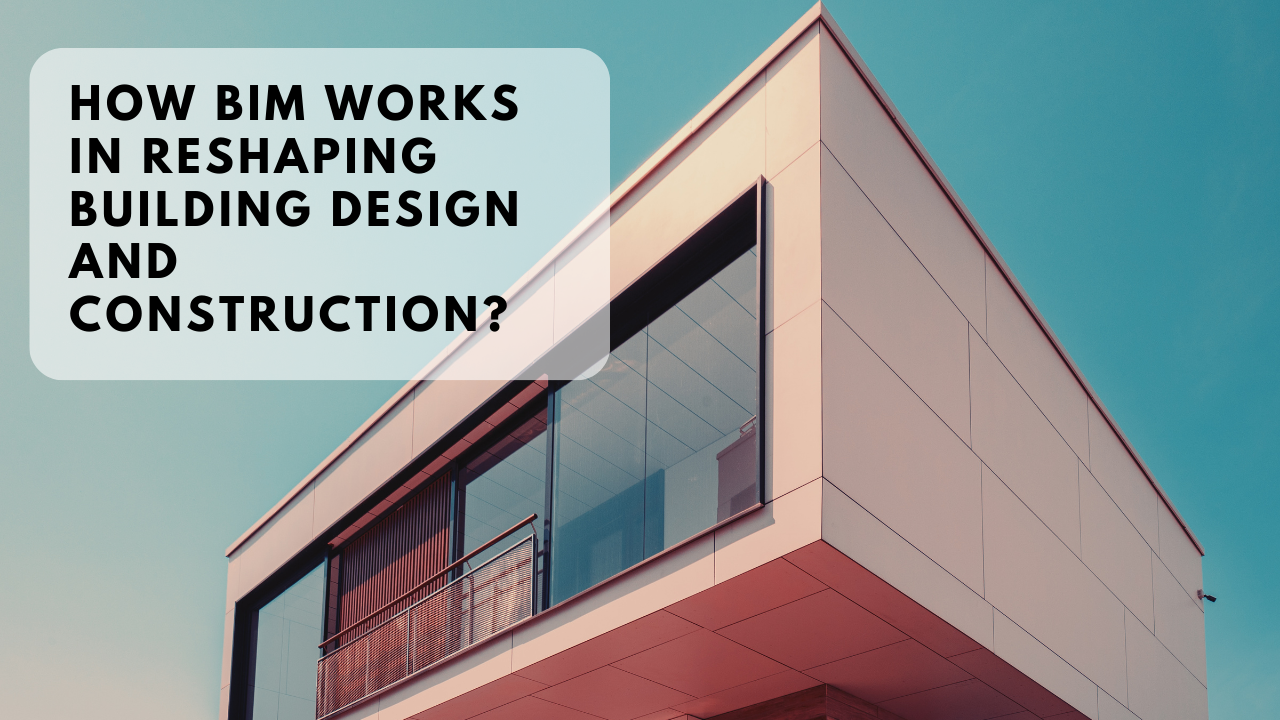How BIM Works in Reshaping Building Design and Construction?


In the rapidly evolving landscape of architecture and construction, technological advancements have become instrumental in transforming the way buildings are conceptualized, designed, and brought to life. One such revolutionary innovation is Building Information Modeling (BIM), a dynamic digital process that has profoundly reshaped the building design and construction industry. BIM transcends traditional methods by offering a collaborative, multidimensional approach that enhances efficiency, accuracy, and communication throughout the entire project lifecycle.
Contents
Understanding Building Information Modeling (BIM)
At its core, BIM is a sophisticated digital process that involves creating and managing a comprehensive 3D model of a building’s physical and functional characteristics. Unlike conventional methods, where separate entities work on disjointed designs, BIM encourages interdisciplinary collaboration. Architectural, structural, mechanical, and electrical elements are seamlessly integrated within a single digital model, enabling stakeholders to visualize, analyze, and optimize every aspect of a project.
Definition and Core Concept
Building Information Modeling, commonly referred to as BIM, is a sophisticated digital process that involves the creation and management of a comprehensive 3D model that captures both the physical and functional characteristics of a building. Unlike traditional 2D drawings, BIM generates a holistic digital representation, serving as a central repository for architects, engineers, contractors, and other stakeholders to collaboratively work on and access critical project information.
Evolution from Traditional Methods
BIM represents a paradigm shift from conventional design and construction approaches. In the past, various entities worked on isolated plans, often leading to misinterpretations and errors. BIM, on the other hand, encourages interdisciplinary collaboration by integrating architectural, structural, mechanical, and electrical elements within a unified digital model. This integration promotes a holistic understanding and analysis of a project, leading to improved decision-making and project outcomes.
What are the Components of BIM?
The components of Building Information Modeling (BIM) encompass its fundamental attributes that contribute to its transformative capabilities. BIM’s core lies in generating accurate 3D geometry, enabling stakeholders to visualize designs comprehensively. Moreover, it integrates diverse data, including material specifications and cost estimates, enhancing decision-making precision.
1. Geometry and Visualization
At the core of BIM’s effectiveness lies its proficiency in crafting precise and intricate 3D geometry. This feature allows architects, engineers, and other stakeholders to visualize the design from multiple angles and perspectives, facilitating a deeper understanding of spatial relationships and aesthetics. The dynamic nature of the 3D model enhances communication and aids in more informed design decisions.
2. Data Integration
BIM goes beyond visual representation by incorporating a wealth of data beyond just geometry. It encompasses information related to materials, costs, scheduling, and even sustainability factors. This data-driven approach empowers stakeholders to make well-informed decisions, leading to optimized resource allocation, cost savings, and improved project outcomes.
3. Interoperability
BIM software platforms are designed for seamless interdisciplinary collaboration. Unlike traditional methods that often involve navigating through various file formats, BIM tools enable real-time communication among different disciplines. This interoperability minimizes errors that can arise from incompatible software and ensures that all stakeholders are working with accurate and up-to-date information.
The BIM Workflow: Reshaping Building Design
The BIM workflow revolutionizes building design by encompassing several key stages. Initially, architects employ BIM tools to craft intricate digital models, enabling them to explore spatial arrangements and aesthetic elements. Engineers then conduct structural analyses and simulations within the BIM environment to identify potential issues before construction begins. Collaborative coordination thrives as BIM seamlessly integrates architectural, structural, and MEP designs, minimizing conflicts and rework.
1. Design and Conceptualization
Architects leverage BIM tools to create intricate digital models that vividly capture their design concepts. This three-dimensional representation allows them to explore spatial relationships, lighting effects, material choices, and overall aesthetics in a highly interactive and intuitive manner.
2. Structural Analysis and Simulation
BIM’s capabilities extend beyond aesthetics and into engineering analysis. Engineers utilize BIM for structural assessments and simulations, identifying potential issues and optimizing the building’s performance before construction begins. By detecting structural concerns early in the process, BIM contributes to cost savings and streamlined construction workflows.
3. Collaborative Coordination
BIM fosters collaborative coordination among diverse disciplines involved in a project. Through the digital model, architectural, structural, and MEP (Mechanical, Electrical, Plumbing) designs can be seamlessly integrated. Clash detection tools within BIM software identify and resolve conflicts before they manifest on the construction site, reducing rework and ensuring smoother project execution.
Transforming Construction Practices with BIM
Building Information Modeling (BIM) is a transformative force in construction practices, optimizing various aspects of project execution. BIM facilitates efficient construction planning by generating precise schedules and resource allocation based on the digital model. Enhanced communication among stakeholders is facilitated through BIM’s visual representation, leading to informed decision-making and reduced misunderstandings. Real-time updates and documentation within BIM models ensure that all parties work with accurate, up-to-date information, minimizing errors and discrepancies during construction.
1. Efficient Construction Planning
BIM streamlines construction planning by generating precise schedules and sequencing based on the digital model. Contractors can optimize workflows, allocate resources efficiently, and minimize project delays. This meticulous planning contributes to more streamlined project execution and enhanced project timelines.
2. Enhanced Communication
BIM serves as a visual and data-rich communication medium among project stakeholders. Contractors, subcontractors, and owners can easily comprehend the design intent, leading to more informed and efficient decision-making processes. This enhanced communication reduces misunderstandings and ensures alignment among all parties involved.
3. Real-time Updates and Documentation
As construction progresses, BIM models can be continuously updated to reflect the as-built conditions. This dynamic feature ensures that all stakeholders are working with accurate and up-to-date information, reducing errors and discrepancies. Real-time updates enhance decision-making accuracy, streamline communication, and facilitate construction progress.
What is BIM’s Role in Facility Management and Beyond?
BIM’s role extends beyond construction, playing a pivotal role in facility management and various aspects beyond the initial building phase. In facility management, BIM serves as a valuable resource, offering an interactive platform for accessing vital information about equipment, maintenance schedules, spatial layouts, and more. This centralized repository streamlines ongoing building management, aiding in efficient operations and reducing downtime.
1. Handover and Facility Management
BIM’s benefits extend beyond the construction phase. During the handover process, the BIM model becomes a valuable resource for facility managers. It provides an interactive platform for accessing information about equipment, maintenance schedules, spatial layouts, and other essential data. This centralized repository simplifies ongoing building management.
2. Renovation and Retrofitting
BIM proves indispensable when buildings require renovation or retrofitting. The existing BIM model serves as a reference point for architects and contractors, guiding design decisions and helping them understand the building’s existing conditions. This streamlined approach reduces uncertainties and enhances the accuracy of renovation projects.
Conclusion
Building Information Modeling has ushered in a new era of innovation in the construction industry. Its multidimensional approach transforms the way buildings are designed, constructed, and managed, fostering collaboration, accuracy, and efficiency throughout the project lifecycle. By integrating data, visualization, and interdisciplinary coordination, BIM ensures that the future of building design and construction is built upon a foundation of excellence. As technology continues to advance, the role of BIM will undoubtedly expand, continuing to shape the buildings and cities of tomorrow. If you are located near Austin, Texas do contact an expert Building Information Modeling Consultant for all your reshaping building design and construction needs.








